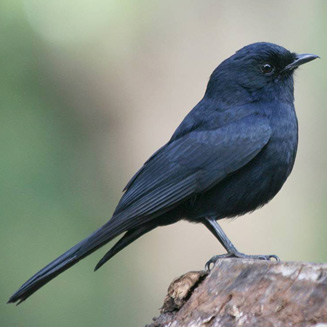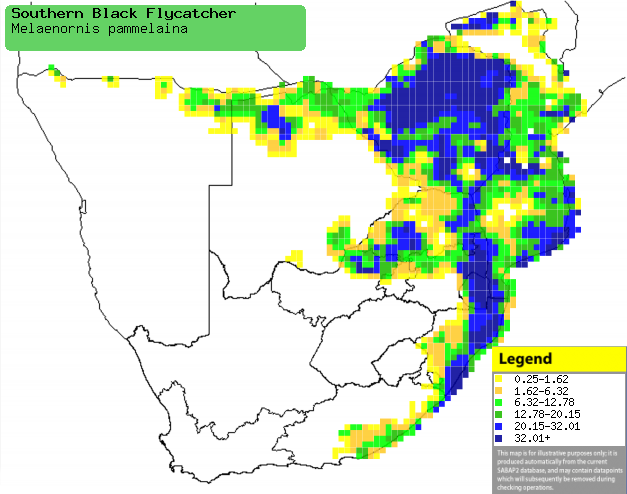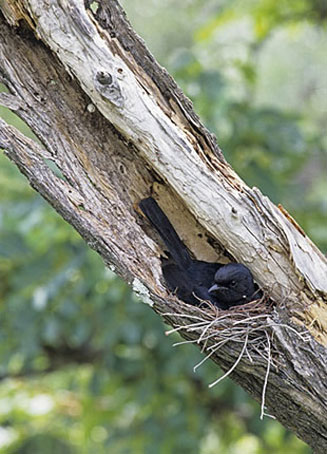|
Melaenornis pammelaina (Southern black
flycatcher)
SwartvlieŽvanger [Afrikaans]; umMbesi
[Zulu]; Ndiru [Kwangali]; Nhengu, Nhengure (both names also applied to
Fork-tailed drongo) [Shona]; Kaapse drongovliegenvanger [Dutch];
Gobemouche sud-africain [French]; Drongoschnšpper [German];
Papa-moscas-preto-meridional [Portuguese]
Life
> Eukaryotes >
Opisthokonta
> Metazoa (animals) >
Bilateria >
Deuterostomia > Chordata >
Craniata > Vertebrata (vertebrates) > Gnathostomata (jawed
vertebrates) > Teleostomi (teleost fish) > Osteichthyes (bony fish) > Class:
Sarcopterygii (lobe-finned
fish) > Stegocephalia (terrestrial
vertebrates) > Tetrapoda
(four-legged vertebrates) > Reptiliomorpha > Amniota >
Reptilia (reptiles) >
Romeriida > Diapsida > Archosauromorpha > Archosauria >
Dinosauria
(dinosaurs) > Saurischia > Theropoda (bipedal predatory dinosaurs) >
Coelurosauria > Maniraptora > Aves
(birds) > Order: Passeriformes
> Family: Muscicapidae
 |
 |
|
Southern black flycatcher, South Africa. [photo
Callie de Wet ©] |
Southern black flycatcher, KwaZulu-Natal, South
Africa. [photo Alan Manson
©] |
Distribution and habitat
Occurs from Kenya, southern DRC and Tanzania through Angola
and Zambia to southern Africa. Here it is common throughout the eastern and
northern areas of the region, generally preferring habitats with tall vegetation
and patches of open ground, such as miombo (Brachystegia), Mopane (Colosphermum
mopane), Acacia and riparian woodland types, also occupying gardens
and the edges of plantations.
|
 |
|
Distribution of Southern black flycatcher in
southern Africa, based on statistical smoothing of the records from
first SA Bird Atlas Project (©
Animal Demography unit, University of
Cape Town; smoothing by Birgit Erni and Francesca Little). Colours range
from dark blue (most common) through to yellow (least common).
See here for the latest distribution
from the SABAP2. |
Predators and parasites
It has been recorded as prey of
Falco peregrinus
(Peregrine falcon).
Food
It mainly eats insects, doing most of its foraging from a
low perch, such as a fencepost or the outermost, lowest branch of a tree, from
which it pounces on prey on the ground and in the air. It may also glean prey
from leaves and branches, and it occasionally joins mixed-species foraging
flocks, especially with
Fork-tailed drongos. The following food items have been recorded
in its diet:
- Invertebrates
- Plants
- nectar of Aloe marlothii (Mountain aloe)
- berries of Solanum nigrum (Black nightshade)
Breeding
- The nest (see image below) is a shallow, thin-walled cup usually built of
dry grass and other plant material, on a foundation of twigs, lined with
fine rootlets. It is typically placed in a hollow, such as a cavity in a
tree trunk left by a falling branch or behind peeling bark of a burnt tree,
less commonly in the broken light of an abandoned tractor, creeper tangles,
banana bunches and palm sheaths.
 |
|
|
Southern black flycatcher at its nest, Sericea
farm, South Africa |
|
- Egg-laying season is from about May-January, peaking from
September-October.
- It lays 1-4 egg, which are probably incubated by the female for 13-16
days.
- The chicks are fed by both parents, leaving the nest after about 15-20
days.
Threats
Not threatened.
References
-
Hockey PAR, Dean WRJ and Ryan PG 2005. Roberts
- Birds of southern Africa, VIIth ed. The Trustees of the John Voelcker
Bird Book Fund, Cape Town.
|
